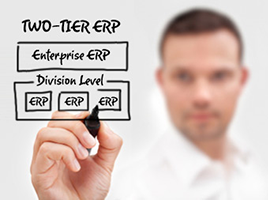ERP Pricing: Get 2019 pricing on 45 different ERP systems. Click to download your free guide.
Any futurist should tread very carefully when they make predictions about an end to innovation. The founder of Digital Equipment is reported to have said in 1977 that “there is no reason for any individual to have a computer in his home” while a young man by the name of Bill Gates allegedly claimed that 640K of RAM “ought to be enough for anybody”. Both dispute that they said the words attributed to them – but then anyone who has been so spectacularly wrong would be keen to take such a statement back. We can see the march of technological innovation with our own eyes without ever switching on a computer. Movies that wowed audiences with cutting-edge visual effects only a few years ago, can look cheap and dated now. Continual progress means that we think of the pinnacle of progress as just one more stop on the journey upwards. But Enterprise Resource Planning (ERP) software hasn’t been wowing its audience for quite some time. Almost all innovation—if it can be described as such—for around a decade has been mostly tinkering at the edges, rather than delivering anything truly revolutionary. And yet licensing costs remain the same. What exactly are users paying for?

Does moving to the cloud count as innovation?
It’s unfair to say that there has been zero innovation in ERP in recent years, but it would be fair to say that change has slowed since the 2000s. The 1990s saw the term ERP coined by Gartner to describe “back office” software that included HR, accounting and project management.
A decade later, a host of innovations such as real-time access, integration with supply chain management, CRM and business intelligence, and mobile UIs excited Gartner enough that they declared these to be “ERP 2”. These advances were enough to merit a whole new name.
Since then, there has been no declaration by Gartner of “ERP 3”. New innovations have been mostly iterations of previous versions—better integration, faster access, tweaked and modernized user interfaces.
Why is that?
One reason for the lack of innovation of on-premise ERP software is as simple as it is disturbing: vendors such as Oracle and SAP just don’t want to sell it anymore. They do not see it as a flagship product anymore.
They’re quite happy to continue to sell licenses and support for these products, of course, but they would much rather have their customers move to their shiny new SaaS products.
Both SAP and Oracle heavily promote SaaS versions of their ERP applications (S/4 Hana Enterprise Cloud and Oracle Cloud Platform ERP) over the on-premise versions. SAP in particular is so keen to move its customers to its SaaS platform that it has set a 2025 end-of-support deadline to hurry this process along.
It’s easy to see why: earlier this year, SAP announced that it had almost doubled the number of customers using its SaaS product from 5,400 to 7,900—but as the company serves over a quarter of a million businesses, it’s understandably keen to have a bigger chunk of them using its newest product.
SaaS does have advantages for the customer. Security patches and updates are automatically applied and organizations no longer need to maintain their own infrastructure.
However, switching is not a simple process. Many organizations have heavily modified running code to meet their specific needs, and SAP’s 2025 deadline has already been pushed back as migration is a process that is likely to take several years to complete.
The biggest innovation in ERP in recent years is the move to SaaS services. And while it does have benefits for customers, it’s more advantageous for the vendor instead.
Is innovation necessary?
Of course, it may well be that revolutionary innovation simply isn’t necessary. Maybe tinkering is all that’s needed to make sure that ERP works, to give organizations the tools they need to support what they need.
ERP is, to go back to the movie effects analogy, less like the computer-generated superheroes of recent movies that get exponentially better with every release, and is more like the in-camera practical effects that powered 1970s horror movies. Meaning that despite their age, they still deliver the necessary impact and don’t date nearly as quickly as CGI.
If it ain’t broke, why fix it? Organizations have pretty much the same needs when it comes to human resources, accounting and project management as they did a decade ago. So, if the software that coped a decade ago can still cope with these demands, then there’s really no need to add bells and whistles such as voice integration or artificial intelligence.
We may be at the “end of history” for Enterprise Resource Planning. All the important work has already been done, and what we have now will be good enough for some time to come.
Unfortunately, this leaves us with yet another problem: the question of licenses.
What are businesses with licenses for this software actually paying for?
It’s not part of any official licensing agreement, but there’s an implicit agreement that part of this ongoing cost is down to the ongoing development of the next iteration. A license is not just paying for this version, but is also an investment in the next one.
If ERP innovation is at a standstill, and vendors are focused on their SaaS offerings, some may be wondering why the licensing costs for on-premise software remains the same for a product that is not getting any better.





